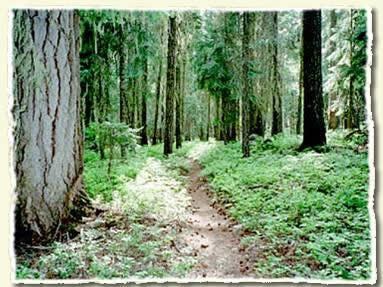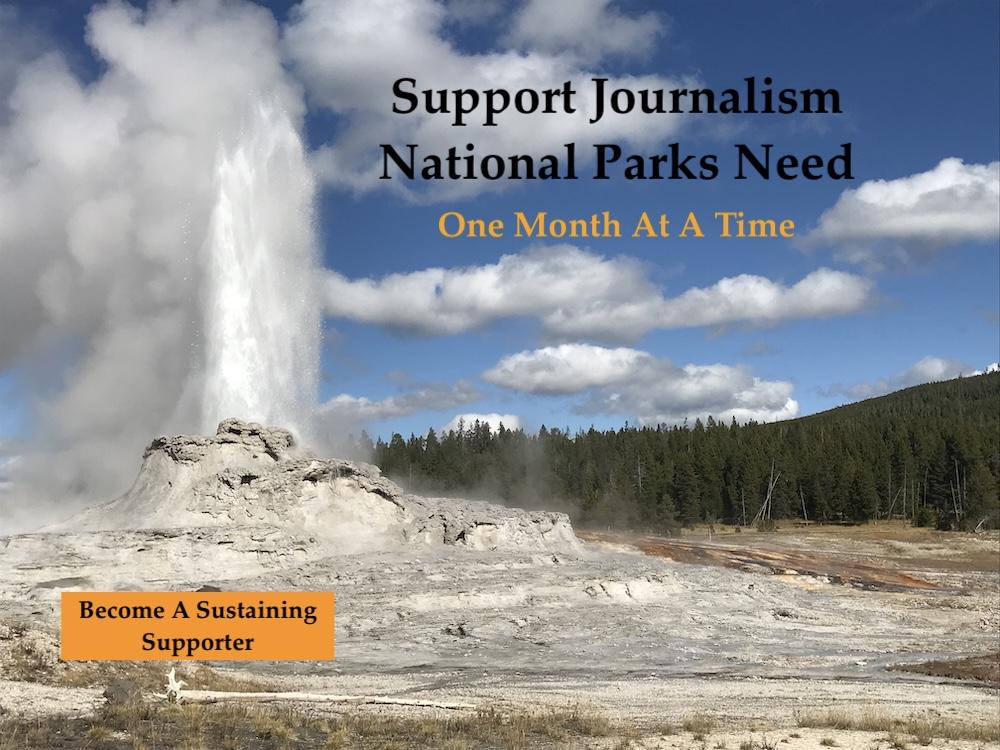The Pacific Crest Trail ranges from Canada to Mexico, running through Washington, Oregon, and California along the way, traversing not one but seven units of the National Park System in the process.
On its way north and south portions of the trail touch or run through parts of Yosemite National Park, Sequoia National Park, Devils Postpile National Monument, Crater Lake National Park, Mount Rainier National Park, Lassen Volcanic National Park, and North Cascades National Park.
While mountain bikers are not supposed to use the Pacific Crest Trail, recently some have been poaching sections in California. While the poaching did not occur in any national park sections, some have concerns that a rule currently pending in the Interior Department could open more national park trails to mountain bikes and, in the process, lead to the following scenario.
In its February issue, the PCT Communicator, the magazine of the Pacific Crest Trail Association, reported on trail damage committed by mountain bikes near the Parks Creek Trailhead in the Shasta-Trinity National Forest in California.
From Big Bear to the Tehachapi Mountains in southern California, to Donner Summit and the Sierra Buttes north of Lake Tahoe, to Castle Crags and beyond, mountain bikes on the trail are causing damage and creating a number of "PCT Places in Need."
According to the trail association, "under U.S. Government regulation, bikes are prohibited in the PCT. The rationale for the prohibition of bicycles is based on the "nature and purpose" of the PCT, as dictated by the intent of Congress with the National Trails System Act and subsequent regulations designed to protect the experience of the primary users. The Code of Federal Regulations (36 CRF 212) directs that "The Pacific Crest National Scenic Trail as defined by the National Trails Systems Act, 82 Stat. 919, shall be administered primarily as a footpath and horseback riding trail."
"Unfortunately, however, U.S. regulations and regulators have not, thus far, been able to fully curb the illegal use of the PCT by mountain bikers," adds the article. "The resulting trail damage and user conflicts can't be taken lightly. To complicate matters, bikes are permitted on many trails that lead to the PCT, resulting in bikers reaching the PCT on such trails and then proceeding along the PCT to pick up another feeder trail. Given land management agency staffing and budget issues, policing and enforcement is sorely lacking."
The article goes on to point out the problems associated with mountain bikes on the Pacific Crest Trail: the trail was not engineered to handle mountain bike traffic, it can be easily and quickly ripped up by bikes riding in wet and muddy conditions, erosion problems can arise.
"I can't stress enough the importance of responsible trail users reporting illegal uses of the PCT," says Ian Nelson, the trail association's regional representative for northern California and southern Oregon. "It is crucial that we hear from concerned users so that we and our agency partners can strategize as to how to curb the illegal use."


 Support Essential Coverage of Essential Places
Support Essential Coverage of Essential Places







Comments
You are correct Zebulon (not verified) that I am bias and a card carrying member of the Sierra Club.
I am a preservationist believing in the intrinsic value of wilderness itself and the National Parks mandate "to conserve the scenery and the natural and historic objects and wildlife therein, and to provide for the enjoyment of the same in such manner and by such means as will leave them unimpaired for the enjoyment of future generations."
I abhor the continuous lobbying for more development in our National Parks and Wildernesses; be it buildings, roads or trails for mountain bikes, horses or boots, and the belief that nature should conform to the trends of society.
"Every recreationist whether hiker, biker, horsepacker, or posey sniffer should not begin by asking, 'What's best for ME?' but rather 'What's best for the bears?'" ~Tom Butler~
Random Walker, well put...well put! I couldn't agree more with you.
The impact on trails is always brought up as a point to exclude mtbers despite many studies showing the opposite. Nobody is asking to build north shore stunts (for the uninitiated, google whistler bike park) or to create shuttle runs in Yellowstone.
Volunteer trail work: I've seen plenty of ppl showing up where I am. I'm guessing that as a percentage, MTBers show up for trailwork as much as other categories of users (i.e. the vast majority never bothers...).
Share the trail: I go plenty fast whenever possible and safe to do so, but I slow down when encountering hikers/equestrians like just about everybody else I know and ride with. Again, the trail sharing issue is overblown. Most users don't venture more than 1-2 miles into the park. Make separate trails near the trailhead and that would resolve 95% of the conflicts (not a study, just my guess).
Random Walker: sharing existing trails in a responsible manner (which is all I'm asking for) does in no way conflict with preserving nature. It's always the same thing: the nature protection is just a rationalization to not share.
You know, I cannot hike for more than a few miles due to bad knees, but I can ride for many many more because there isn't the impact on my knees. Does this mean I should try and get some trails within the park service designated wheeled access for people like me? Am I being discriminated against because my knees are bad?
I agree, Richard...I think it's time to sell off the parks to the highest bidder. Soon we won't be allowed to breathe...too much "carbon!" Frickin' ridiculous.
Time to write some letters. And I bet the liberal moderator won't post this, just like many of my posts.
Guess you lost that bet, eh?
While I don't agree with Kurt on a few subjects, I certainly applaud his desire to engage in dialogue with people he disagrees with.
Kurt, I don't think that MTBers will call the shots in the future, but I believe that once we reach critical mass, it'll be harder for any administration to keep discriminating against us. I don't wish to kick anybody out of the parks/wilderness. I just want to share.
You know, I cannot hike for more than a few miles due to bad knees, but I can ride for many many more because there isn't the impact on my knees. Richard Smith.
Richard, I also can no longer hike any appreciable distance, but I am easily able to cycle. Should I be permitted to ride a mountain bike on backcountry trails in a national park? My answer is, no. Frankly, I want primitive areas to remain primitive. I also want as many people as possible to literally step away from mechanical transportation devices and walk slowly and, hopefully, quitely into the natural setting. I want them to hear the small sounds of nature and to focus on the multitude of details surrounding them. If they chance to see wildlife near the trail I hope they stop and take the time to treasure the experience. Just as most mountain bikers would not want to compete with motorized ATVs on backcountry trails, there should be special places, especially national parks, where hikers can walk on trails free of mountain bikes.